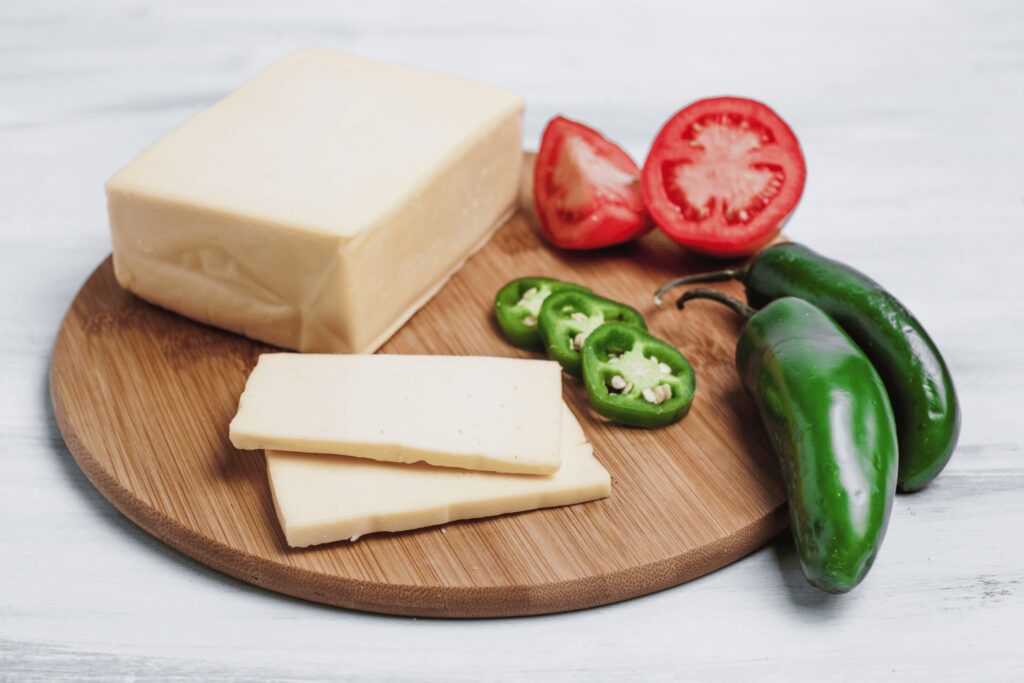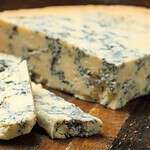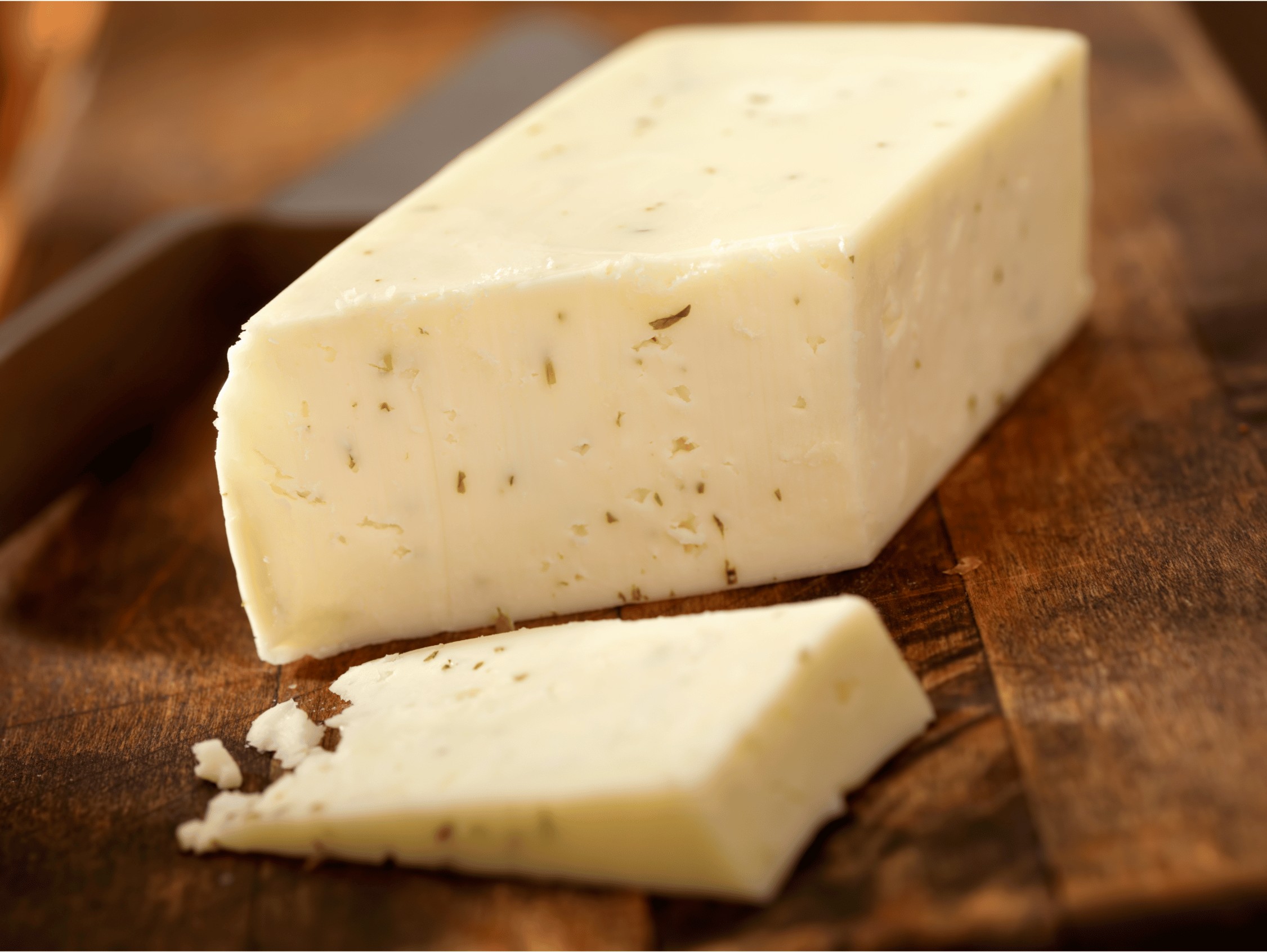Chihuahua cheese is a Mexican cheese known for its rich flavor and excellent melting properties. It originates from the Mexican state of Chihuahua, and its creamy texture and mild taste have made it a popular choice in both Mexican and Tex-Mex cuisines. We appreciate Chihuahua cheese not only for its taste but also for its versatility in cooking.
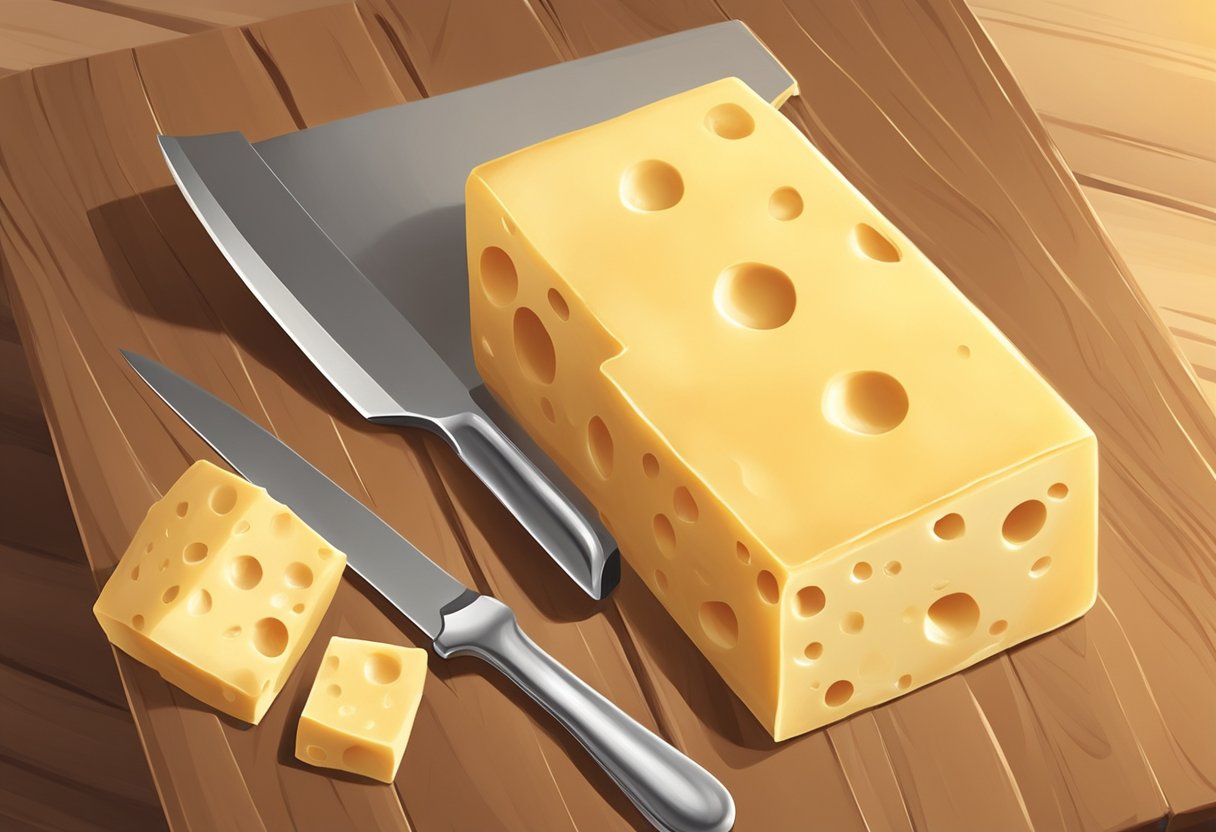
This type of cheese is traditionally made from cow’s milk and is similar to a mild cheddar or Monterey Jack, although it carries a distinct tanginess that sets it apart. Chihuahua cheese is often used in dishes that require a cheese that melts well, such as quesadillas, enchiladas, and chiles rellenos. Understanding the characteristics and nutritional profile of Chihuahua cheese can aid us in making informed dietary choices, especially for those who enjoy incorporating cheese into their meals.
Key Takeaways
- Chihuahua cheese is a versatile, melting cheese originating from Mexico.
- Its flavor is mild and creamy, commonly used in Mexican and Tex-Mex cooking.
- Knowledge of characteristics and nutritional information assists in making informed dietary choices.
What Is Chihuahua Cheese?
Chihuahua cheese, also known as queso Chihuahua or queso menonita, is a type of Mexican cheese originally from the Chihuahua region of Mexico. We recognize this cheese for its pale yellow color and its semi-soft texture, which makes it quite versatile in the kitchen.
Origin and Production:
Chihuahua cheese was first made by the Mennonite communities in Mexico, and it’s traditionally crafted from cow’s milk. Its production involves a process similar to that used for making cheddar, which includes pressing the cheese into molds after the curdling and whey removal stages.
Taste Profile:
Typically, Chihuahua cheese has a mild and slightly nutty flavor that can vary in intensity depending on the age of the cheese. A younger Chihuahua cheese will be milder and creamier, while an aged version develops a sharper, more complex taste.
Usage:
This cheese is excellent for melting, making it a popular choice for dishes like quesadillas, chiles rellenos, and as a topping for beans and nachos. Its ability to melt smoothly and its gentle flavor profile add delightful creaminess to a variety of recipes.
Here’s a quick breakdown of what Chihuahua cheese is made of and its taste characteristics:
- Composition: Made primarily from cow’s milk.
- Texture: Semi-soft and creamy.
- Flavor: Mildly nutty; sharpens with age.
In summary, we appreciate Chihuahua cheese for its melting qualities and adaptable flavor, which complement a range of Mexican cuisine dishes. Its origins tie back to the Mennonite community of Chihuahua, and its making process lends itself to a cheese that is both distinctive and a staple in many households.
Origins and History
We will explore the roots of Chihuahua cheese, tracing its origin back to the northern part of Mexico. This cheese has a rich history intertwined with the heritage of the Mexican state of Chihuahua and the traditions brought by Mennonite communities.
Mexican State of Chihuahua
Chihuahua cheese, also known as Queso Chihuahua, is a product that originates from the northern region of Mexico, specifically the Mexican state of Chihuahua. It’s a semi-soft cheese, known for its mild and slightly tangy flavor, which has become a staple in the local cuisine. The origins of this cheese are rooted in the farming practices and dairy production skills of the region’s inhabitants, reflecting the agricultural tradition of northern Mexico.
- Location: Northern Mexico, Chihuahua State
- Characteristics: Semi-soft, mild flavor, tangy
Mennonite Communities
The development and popularization of Chihuahua cheese are significantly attributed to the Mennonite communities that settled in Mexico in the 1920s. These communities brought with them their dairy farming expertise and cheese-making traditions from Europe, which they adapted to the local Mexican environment. Over time, the Mennonites refined their cheese-making process, leading to the creation of what we now recognize as Chihuahua cheese.
- Arrival: 1920s
- Contribution: Dairy farming expertise, cheese-making traditions
By combining local ingredients and methods with their traditional techniques, the Mennonite communities played a crucial role in establishing Chihuahua cheese as an integral part of Mexican culinary tradition.
Characteristics of Chihuahua Cheese
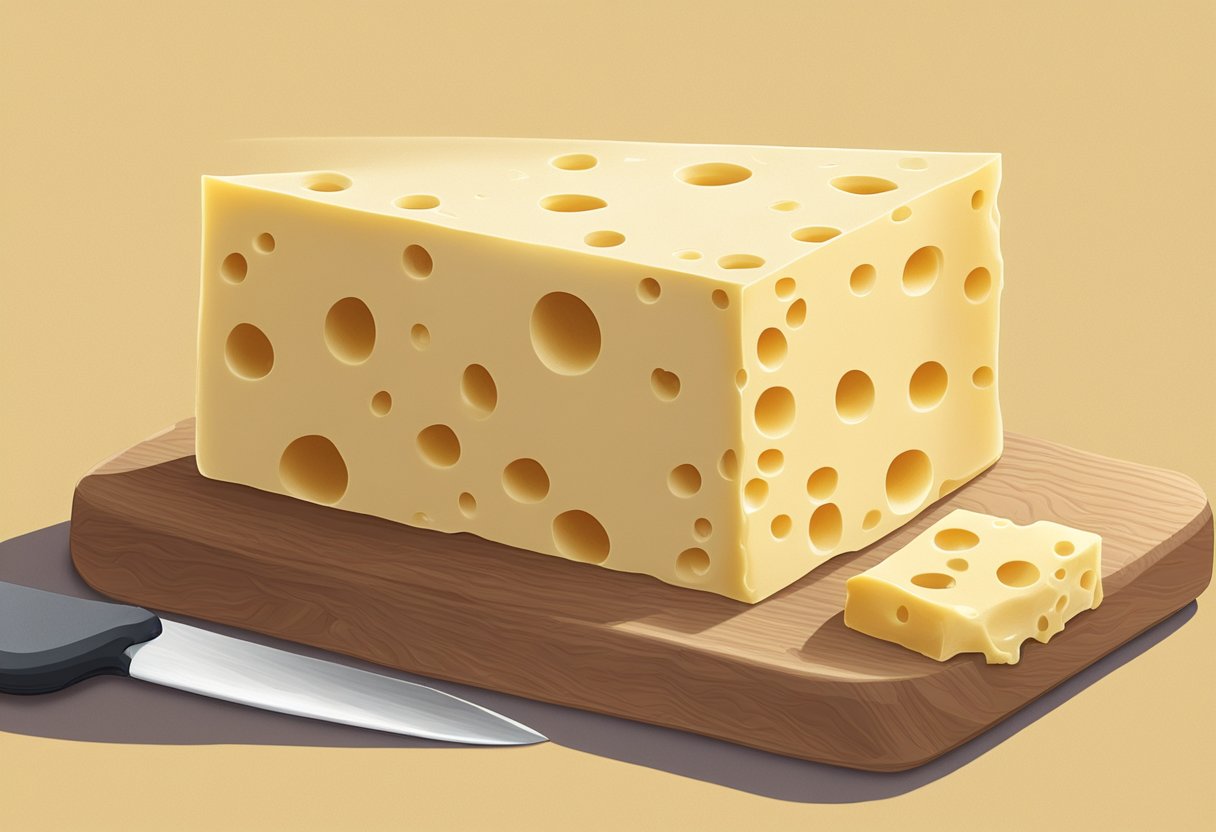
In discussing Chihuahua cheese, we focus on its distinctive color and texture, flavor profile, and melting properties which are essential for culinary applications.
Color and Texture
Chihuahua cheese boasts a pale yellow to white hue, a sign of its pure milk origins. Its texture is notable for being remarkably smooth, and when fresh, it provides a pleasant firmness that’s neither too hard nor too soft. This positions it as a versatile cheese in both texture and appearance, making it suitable for various dishes.
Flavor Profile
Our Chihuahua cheese presents a mild flavor with a creamy undertone. You may discern a slightly tangy taste as well, but overall it strikes a balanced and unobtrusive profile. This mildness renders the cheese well-suited to complement rather than overwhelm the flavors with which it is paired.
Melting Properties
When heated, our cheese displays excellent melting qualities. It melts well, becoming stretchy and gooey, characteristics that are highly desired for dishes such as quesadillas and enchiladas. The melt is consistent, avoiding oiliness, and contributes a delightful, cohesive binding quality to recipes.
Nutritional Information

We examine the nutritional components of Chihuahua cheese, focusing on its protein and fat content, as well as its calorie and sodium levels. Understanding these factors is essential for those monitoring their dietary intake.
Protein and Fat Content
Chihuahua cheese is a rich source of protein, typically providing about 7 grams per 1-ounce serving. It also contains a considerable amount of fat, with an average of 9 grams per serving, out of which 5 grams are saturated fats.
Calories and Sodium
A 1-ounce serving of Chihuahua cheese contains approximately 110 calories. When considering sodium levels, Chihuahua cheese has about 190 milligrams of sodium per serving, which is relevant for those on a sodium-restricted diet.
Culinary Uses

Chihuahua cheese is a versatile addition to numerous dishes in Mexican cuisine, prized for its excellent melting qualities and subtle flavor. We find it a staple in both traditional and innovative recipes, commonly used as a topping or melted ingredient to enhance the taste and texture of the dish.
Popular Dishes
- Enchiladas: We often layer Chihuahua cheese over the tortillas before baking, providing a gooey, sumptuous topping.
- Quesadillas: A quintessential cheese for quesadillas, its melting properties make it a favorite.
- Tacos: Sprinkled over tacos, Chihuahua cheese adds a delightful stringiness and flavor.
- Nachos: Ideal as a melted topping, it brings nachos together with its rich and creamy texture.
- Queso Fundido: Perfect as the main cheese in this melted cheese dip, often combined with chorizo.
- Empanadas: We fill these pastries with Chihuahua cheese for a soft, warm interior.
- Tamales: Often incorporated into the masa or as a filling, adding a mild cheesy essence.
- Omelets: Delivers a touch of Mexican flair to omelets when melted within.
Cheese Pairings and Substitutes
When pairing or substituting Chihuahua cheese, we consider its characteristics:
-
Substitute Table:
If you don’t have Chihuahua cheese, use: Monterey Jack (similar melting qualities) Mozzarella (for a milder taste) Oaxaca Cheese (comparable stringiness) -
Fondue: We often merge it with cheddar or Monterey Jack for a balanced flavor profile.
-
Grilled Cheese: Mix with cheddar to add depth to your grilled cheese experience.
-
Topping: Alongside mozzarella, it boosts the stretchiness and flavor of pizza and similar dishes.
Comparative Cheese Analysis

In this section, we explore the distinctive qualities of Chihuahua cheese in comparison to other well-known cheeses, focusing on taste, texture, and melting properties.
Chihuahua vs Cheddar
When comparing Chihuahua cheese with different types of cheddar, it’s essential to note that Chihuahua cheese has a taste and texture that can be similar to mild cheddar but is distinctly creamier. The sharpness of cheddar varies across its types:
- Mild Cheddar: Creamy and subtle flavor, less intense compared to Chihuahua.
- Medium Cheddar: Balanced sharpness, still softer than the zest of Chihuahua.
- Sharp Cheddar: Bold and tangy, with a bite that overshadows Chihuahua’s gentler taste profile.
Here’s a quick breakdown of their texture differences:
| Cheese Type | Texture |
|---|---|
| Chihuahua | Creamy, Soft, Smooth |
| Mild Cheddar | Creamy, Semi-Soft |
| Medium Cheddar | Firmer, Slightly Crumbly |
| Sharp Cheddar | Firm, Crumbly, often Granular |
Chihuahua cheese also has a higher moisture content and a melting quality that is superior to that of most cheddars, making it a preferred choice for recipes requiring a smooth, uniform melt.
Comparing Melting Cheeses
When discussing melting cheeses, Chihuahua cheese stands out for its exceptional melting characteristic, which it shares with other popular melting cheeses such as mozzarella, Monterey Jack, and Oaxaca cheese.
Here’s a comparison of their melting features:
| Cheese Type | Melting Quality |
|---|---|
| Chihuahua | Excellent, Smooth |
| Mozzarella | Excellent, Stretchy |
| Monterey Jack | Very Good, Creamy |
| Oaxaca Cheese | Excellent, Stringy |
| Melting Cheese | General term for all the above |
Chihuahua cheese melts uniformly without oiliness, similar to Monterey Jack, but with a creamier result akin to that of mozzarella. Oaxaca cheese, a traditional Mexican cheese like Chihuahua, offers a more stringy melt, often compared to mozzarella but with a distinct buttery flavor. These attributes make Chihuahua cheese an ideal candidate for dishes that require a creamy and consistent melt, such as quesadillas, nachos, and other Mexican-inspired cuisines.
Shopping and Storage Tips
When selecting Chihuahua cheese, we focus on the quality of the milk and the cheese’s physical characteristics. Storing the cheese correctly ensures it retains its flavor and texture.
How to Select High-Quality Cheese
- Source of Milk: We opt for cheese made with high-quality milk, which significantly influences taste and texture. The milk should be fresh and from cows that are well-fed and healthy.
- Moisture and Texture: The ideal Chihuahua cheese should appear moist but not wet, indicating proper cheese-making technique and freshness.
- pH Levels: A balanced pH, which contributes to the right level of acidity, is crucial for the development of the cheese’s flavor and texture.
- Mineral Content: We check for adequate levels of calcium and phosphorus, which are essential for the cheese’s structure and nutritional value.
Proper Storage Practices
- Temperature: Store Chihuahua cheese in the refrigerator, ideally between 35 to 40°F (1.7 to 4.4°C), to maintain its moisture and prevent spoilage.
- Humidity: Keep the cheese in a high-humidity drawer or a dedicated cheese container to protect its texture.
- Airtight Packaging: Use cling film, foil, or an airtight container to prevent the cheese from absorbing other flavors and aromas in the fridge.
- Shelf Life Awareness: Consume the cheese within two weeks of opening for best quality. Unopened, it can last for the duration indicated on its packaging.
Preparation and Cooking Techniques
Chihuahua cheese is versatile in Mexican cuisine, offering a buttery flavor and excellent melting qualities. We’ll guide you through the optimal methods to cut and grate this cheese for use in various dishes, as well as the best practices for cooking to enhance flavor and texture.
Cutting and Grating
- Shredded Chihuahua Cheese: For shredding, we recommend using a box grater or a food processor with a grating attachment. Shredded Chihuahua cheese melts evenly and is perfect for:
- Tacos
- Quesadillas
- Casseroles
- Block Cheese: If starting with a block of Chihuahua cheese, it’s best to chill the cheese before cutting it. This makes it firmer and easier to shred.
- Clean Grater: Ensure the grater is clean and dry to prevent sticking, which can affect the texture of the shredded cheese.
Cooking Different Cheese Dishes
-
Melting: Chihuahua cheese is ideal for melting due to its creamy texture. Use low to medium heat to prevent the cheese from becoming oily or clumpy.
-
Sauces: When incorporating into sauces, add the shredded cheese gradually while continuously stirring to promote a smooth consistency.
Mexican Cuisine: We often use Chihuahua cheese in traditional Mexican dishes where cheese is a key ingredient:
- Enchiladas
- Chiles Rellenos
To enjoy the full flavor and texture of Chihuahua cheese in your cooking, ensure a gentle heat and avoid overcooking, which can diminish its buttery qualities.
Cultural Significance
Chihuahua cheese, deeply rooted in the culinary heritage of Mexico, plays a pivotal role in both daily eating habits and festive occasions. As a cornerstone of Mexican cuisine, it not only imbues traditional dishes with rich flavor but also carries the warmth of generational knowledge within its making.
Influence on Local Cuisine
We see Chihuahua cheese enhance countless regional recipes. It is a key ingredient in:
- Quesadillas: Melted Chihuahua cheese between tortillas.
- Chiles rellenos: Peppers stuffed with cheese before being fried.
The cheese’s melting qualities make it ideal for:
- Casseroles
- Enchiladas: Rolled and baked in a chili sauce.
- Fundido: A melted cheese dish served with tortillas.
Cheese as a Tradition
In tradition, Chihuahua cheese represents more than just sustenance; it serves as a cultural beacon for family and community gatherings. Our cheese-making process involves:
- Hand-milking: Local dairy cows provide the fresh milk.
- Curding: Natural enzymes are used to curd the milk.
- Pressing: The curds are pressed into molds and aged.
This process has been handed down through generations, preserving not just a recipe but a legacy within Mexican culture.
Types and Variations
Chihuahua cheese, originating from Mexico, presents a range of flavors and forms, influenced by aging and molding practices.
Aging and Flavor Changes
Aging significantly impacts the flavor profile of Chihuahua cheese. As it ages, the cheese’s taste evolves from a mild and buttery characteristic to a more tangy and sharp flavor. This maturation process classifies Chihuahua cheese into various types:
- Fresh Chihuahua Cheese: Often semi-soft, with a gentle, buttery flavor, appealing to those who prefer a subtler taste.
- Aged Chihuahua Cheese: Develops a more pronounced tanginess and sharpness, attracting enthusiasts of stronger, more robust cheeses.
Differences in Shapes and Sizes
Chihuahua cheese is not only diverse in flavor but also in its physical form, encompassing a variety of shapes and sizes that may influence texture and are suited for different culinary applications:
- Braids and Balls: Typically found in fresh, semi-soft varieties, these forms are not just visually appealing but also practical for portioning.
- Rounds: Aged Chihuahua cheeses are often molded into rounds, which aids in the even aging of the cheese. Rounds can range in size, affecting the aging process and resulting flavor intensity.
Health Considerations
When we consider the health implications of consuming chihuahua cheese, we need to be aware of potential allergens and dietary restrictions that could affect some individuals, as well as the balance of benefits and risks associated with its nutritional components.
Allergens and Dietary Restrictions
Chihuahua cheese is derived from cow’s milk, which is an important factor for individuals with dairy allergies or lactose intolerance. It contains proteins such as casein and whey that can trigger allergic reactions in sensitive individuals. For those adhering to a vegan diet or with a moral stance against animal products, this cheese is also unsuitable.
- Allergens: Dairy proteins (casein and whey)
- Dietary Restrictions: Unfit for vegan diets and people with lactose intolerance or dairy allergies
Benefits and Risks
Chihuahua cheese offers nutritional benefits such as being a source of calcium and protein.
- Calcium: Essential for bone health
- Protein: Important for muscle repair and growth
However, it is also high in both fat and sodium, which could pose health risks if consumed in excessive amounts. Especially for those with heart conditions or requiring a low-sodium diet, the sodium content in chihuahua cheese should be taken into account. Eating this cheese in moderation is key to balancing its intake.
| Nutrient | Consideration |
|---|---|
| Fat | Monitor intake, particularly saturated fat |
| Sodium | Potential risk for high blood pressure |
Consumer Insights
In this section, we focus on how Chihuahua cheese resonates with consumers, including its popularity and availability in the market.
Popularity and Trends
Chihuahua cheese has cemented its position among cheese lovers who appreciate it for its melting qualities and mild yet distinct flavor. Trending data suggests that its fame is on the rise, particularly among those who value gourmet experiences and seek versatile options for cooking. Chihuahua cheese is often highlighted in social media circles and culinary blogs where enthusiasts share their snacking innovations and recipes.
- Snacking: Increasingly popular in snacking assortments due to its easy-to-consume nature.
- Gourmet Cooking: Gourmet cooks often select Chihuahua cheese for its ability to elevate dishes with its smooth texture and unique taste.
Market Availability
Our insights indicate that Chihuahua cheese is widely available across different grocery chains and specialty stores. It is commonly found in the following:
- Specialty Cheese Shops: High visibility due to the curated selection for discerning consumers.
- Grocery Stores: Broadly stocked in both the deli and dairy sections, often offered in pre-packaged and bulk varieties.
| Store Type | Availability | Remarks |
|---|---|---|
| Specialty Cheese Shops | High | Preferred for authenticity |
| Grocery Stores | Moderate to High | Convenient for regular consumers |
| Online Retailers | Moderate | Accessible for those preferring online shopping |
The cheese’s distribution is evidence of its growing reputation as a versatile choice for both everyday use and special occasions.
Frequently Asked Questions
Chihuahua cheese, often compared to Mozzarella for its melting qualities, is a staple in Mexican cuisine. Here, we explore common inquiries to enhance understanding of its characteristics and applications.
How does Chihuahua cheese compare to Oaxaca cheese in terms of flavor and texture?
Chihuahua cheese possesses a milder, more buttery flavor and a firmer texture that’s excellent for melting. In contrast, Oaxaca cheese, also known for its melting properties, typically has a stringier texture similar to Mozzarella and a slightly tangier taste.
Can you explain the difference between Chihuahua cheese and Monterey Jack?
Chihuahua cheese and Monterey Jack are both mild and melt well, but Chihuahua cheese is naturally moister and more buttery in flavor, whereas Monterey Jack is drier and subtler in taste.
What are the primary ingredients used in making Chihuahua cheese?
Chihuahua cheese is traditionally made from cow’s milk, rennet for coagulation, and a touch of salt. The cheese is then aged for varying durations depending on desired characteristics.
Is there a similarity between Chihuahua cheese and mozzarella in taste or texture?
While not identical, Chihuahua cheese shares a creamy texture and a mild flavor with mozzarella, making it a favored substitute for melted cheese dishes.
Could you provide some common uses or recipes that include Chihuahua cheese?
Chihuahua cheese is commonly used in queso fundido, enchiladas, and quesadillas. Its excellent melting quality also makes it ideal for toppings on burgers and pizzas.
Menonita is a type of Chihuahua cheese originally made by Mennonite communities in Mexico. It’s a semi-soft cheese noted for its smooth texture and mild, somewhat nutty flavor, comparable to a mild cheddar or Gouda.

